Clematis is rightfully considered to be the most spectacular and demanded by Lian among the gardeners. This culture has long challenged the views not only by world breeders and experienced gardeners, but also lovers of beautiful and unusual blooming plants. Due to its manifold of forms and colors, Clematis is able to decorate any plot alone. Each year, breeders take out all new and new varieties of this amazing plants that acquire the best characteristics, a brighter appearance and resistance to adverse environmental conditions.
Content |
More recently, the world learned another bright and simply unforgettable grade Clematis Solidarity, which with its large, rich in red, velvety colors will be a profitable acquisition of any gardener.
In this article, consider the features and description of the large-flowered Clematis solidarity, as well as the options for its use in landscape design. We note important rules and nuances of landing and care for this variety of large-flowered Liana.
Features and morphological description Clematis Solidarity
Clematis can boldly compete with beauty with other exotic plants: their sighted view during flowering is simply amazing the imagination - large and bright flowers in large quantities blooming all the shoots, covering themselves all the supports. All Clematis are rustic perennial plants that can grow in various shapes: in the form of bushes, small trees and Lian. They belong to the genus Clematis and the family of ilok. Clematis Grade Solidarity is a rustic liano, which is most often used to pay artificial and natural supports on the site. The natural area of \u200b\u200bthe habitat of Clematis is the territory of a moderate and subtropical belt of the northern hemisphere. In nature, there are species clematis, which can also be found in Russia, for example, Manchur Clematis. However, Clematis Solidarity is a hybrid variety of breeders, so you can only meet the gardens in the gardens and in the sites.
Clematis is often called Lomonos, which is associated with a rather unpleasant smell emanating from its roots. Often you can meet another name - the Lozinka, which characterizes the appearance of this plant - creeping liaun shoots. The scientific definition of "Clematis" occurred from the Greek word "Klema", which for a long time marked all the curly plants. Since the decorative liaans, this name has been entrenched, although there are other forms of this culture in kind.
Clematis Solidarity is considered a fairly new variety, which was brought by Polish breeders in 2004, after which it quickly spread among the connoisseurs of this plant and won love and popularity of gardeners. This grade of Clematis received a prestigious award in the form of a silver medal at the international exhibition of achievements in flower growing and crop production in the Netherlands "Plantarium 2005". This award has become a kind of recognition of Clematis Solidarity by world gardeners, which highly appreciated the appearance of the Liana and its characteristics. Now Clematis variety solidarity can be purchased at any garden center or specialized flower shop.
Clematis Description Solidarity:
- Clematis Solidarity is a rustic liana, which refers to the Lutikovy family and is a hybrid variety of Clematis, derived in Poland.
- According to the international classification, which is based on the rules of trimming and flowering of Clematis, Clematis grade solidarity refers to the second group of trimming, since this lianen's inflorescences are dismissed both on the shoots of last year and on the shoots of this year. If you take another, simpler classification, then Clematis solidarity refers to the group of large-flowered clematics, which was removed based on inflorescence of various varieties.
- The plant of this variety is a compact plenty liano, which can be maximally to reach 150-160 cm. Judging by the reviews, Clematis Solidarity Gardeners are often used to decorate balconies, terraces, arbors or railing.
- The root system of Clematis of this variety is urine, so Liana can notice a transplant.
- Clematis Solidarity greatly grows, clinging to the support of the leaf cuttings.
- The shoots of Clematis of this variety are thin, dark green shade, very flexible and elastic. The shoots of the last year are weird, grayish green shade.
- On the shoots are the first to appear the leaves, which at Clematis solidarity are complex, consist of 3 small leaflets of pointed shape and slightly toothed edge.
- The leaves are placed on long thin stiffs, which lion rises by support. Sheet plate smooth and shiny, light green.
- Clematis flowering solidarity begins pretty early, approximately at the end of May, and lasts until the autumn, which only adds the values \u200b\u200band decorativeness of this variety of Liana.
- Obohyla flowers are located singly, very large. According to many gardeners, this variety really has the largest inflorescences that can reach 15-16 cm in diameter.
- Clematis flower solidarity from 6 oblong, pointed bright red, saturated shade petals. Sometimes small white spots can be on the petals, also in the center of the petal is visible a brighter longitudinal strip. The surface of the petals of Clematis velvety.
- The structure of the flower is simple, so in the center there is a large number of stamens with purple anthers on very thin pinkish threads.
- At the same time, a large number of colors appear on Clematis, which practically hide the greens of foliage.
- After biting inflorescences on shoots, numerous seeds ripen.
- Clematis solidarity is characterized by good frost resistance. This plant can be attributed to the zone of frost resistance 4-9, which means that this wonderful plant can withstand frosts from minus 1 degree up to minus 29-34 degrees.
- Unlike many other varieties of Clematis, it can grow perfectly both on solar open areas and in a light half.
Using Clematis Solidarity in Landscape Design
Clematis Solidarity is a very beautiful and spectacular plant, so there is nothing surprising that this variety is often used landscape designers to decorate areas and ordinary gardeners to create some kind of compositions in their garden and a household courtyard. Consider the most popular options for using Clematis Solidarity in the design of the site.
- Most often, this grade Clematis is used for vertical landscaping. It is planted along the walls of the house or household buildings and build some special supports from twine or wire. With the help of such a way, you can hide an external non-primary type of household buildings.
- This compact and beautiful plant can also be used to decorate the arbors, the railing of the terrace or veranda, as the altitude of Liana reaches only 1.5 m.
- It is possible to show fantasy and independently come up with an unusual composition on its site using Clematis Solidarity, building a special support for this. As an option, you can build out of the wire or woods a beautiful arch and land from two sides Clematis of this variety. Over time, Liana collapses the arch, thereby making the original composition in the garden or on the plot.
- To grow this Clematis, you can use the most different support: wire, fence, chain grid, twine, railings, and frame frame, such as gazebos.
- Because of its low growth, Clematis solidarity is often used to land in containers and pots, which allows them to put them in a variety of places.
- City inhabitants who do not have a private house and, therefore, the site can also afford to plant such a beautiful and bright Lian. To do this, you can use the balcony. Clematis planted in the container Solidarity will grow perfectly on an outdoor sunny balcony. For its weaving in a balcony, you can also use a conventional wire or grille.
- Clematis solidarity is perfectly combined with decorative decorative shrubs, such as Spiriya or Valina. These Liana can be planted near the flowering plants, creating a common pretty bright composition: hydrangea, roses or budleys.
Clematis reproduction Solidarity: common ways
Clematis Solidarity will become a real decoration of any site. Therefore, it is always worth trying to grow this liana on your own, using the most popular and common methods of reproduction for this. To breed Clematis solidarity on its site, it is important to know all the rules and nuances of each option, the main of which are the following ways: seed reproduction, division of bush, spring and summer grain.
Clematis Seed Detaculation Solidarity
- This method of reproduction is extremely rare due to the fact that it takes a lot of time and will have to wait for the first flowering of such a liana.
- Seeds at Clematis solidarity have large sizes, so they germinate very slowly and unevenly. It takes this process on average from 1.5 to 8 months.
- It is recommended to collect seeds after a complete flow of inflorescences, since the seeds of the current year germinate much faster and the best.
- Large seeds of Clematis solidarity sow directly after the collection - in the fall or at the beginning of winter.
- Many gardeners to accelerate the process of germination of Clematis seeds soak planting material in water tanks for 10 days. In this case, the water needs to be changed 4-5 times a day. Only after that you can start cropping seeds for germination.
- Pick up a suitable container and fill it with a special soil soil, which should consist of equal parts of sand, peat and leaf land. After that, abundantly moisture the soil and decompose the seeds on the surface, which you need to cover the soil layer with a thickness of about 2-3 seed diameters.
- For clematis seeds, solidarity must maintain a temperature of 20-25 degrees.
- The soil is regularly watered through the pallet. After the seedlings appear the first leaves, they are divened to separate tanks and further fuse at room temperature.
- When the last frosts will be afraid, young seedlings are planted in a quiet shaded plot in the open soil.
- The entire season behind the seedlings carefully take care and pinch, they are hidden for the winter, and the next spring is again transplanted on a greater depth.
- Only after 2-3 years, seedlings with a couple of elastic roots and several developed nodes can be transferred to a permanent place.
- That is why, due to the duration of the process itself, Clematis solidarity practically does not determine with the help of seeds.
Clematis reproduction Solidarity division
- This method of reproduction is suitable only for young plants, which are not older than 6-7 years. This is due to the fact that the root system of Clematis solidarity is urine and very quickly grow up, so in the future it will be difficult to dig Lian and this is accompanied by injury to the roots.
- In the spring before the start of active growth, it is necessary to dig a bustard of Clematis Solidarity, then put it on the ground and slightly smooth the roots from the soil.
- Next, take a sharp secateur or knife and divide the cornering of Clematis of this variety into several parts so that each root neck is healthy and developed kidneys.
- Prepare places for their landing and place each defense in a separate landing well.
Crossis reproduction Solidarity
- This is a rather popular way to breed Clematis Solidarity, which has a number of its features. The reproduction of the plot is not distinguished by complexity, even an inexperienced amateur gardener will be able to hold it.
- It can still be called vertical reproduction, as it uses small pots, in which Clematis Solidarity are punished.
- In the spring, prior to the start of active growth of Clematis, and in the case of a variety of solidarity - it is an early spring, select strong and healthy shoots on adult plants, which have healthy nodes. Prepare also several small pots that need to be filled with loose and clean peat in a mix with sand.
- Selected shoots in the site of the node gently pinch in the pots and put the mounting place with soil.
- After that, the pot needs to be burned below the ground level so that water does not spread during watering.
- As the shoots are rooted, the soil is regularly added.
- In the fall you will get strong young Saplings Clematis Solidarity.
Clematis reproduction Solidarity
- Clematis Solidarity can independently propagate with the help of autumn and summer chains. This method is also quite simple and does not require complex actions.
- If you lay the grooves in the summer, it will be more difficult to protect them from frosts. Therefore, gardeners are recommended to use the autumn period for this method of reproduction.
- In about October, reflect strong and healthy shoots, remove the whole foliage and cut the flashing part to the first kidneys.
- After that, carefully collect all the grooves in the harness and put in a specially dugout groove, pre-laying the peat. Top on the taps are also recommended to pour peat, which long holds moisture and passes the air.
- The surface of the soil compact and cover with a sweetheart.
- In the spring shelter is removed, and the place of rooting of the gods is carefully and is abundant.
- After the first sprouts appear, the surface must be closed by humus.
- Already by the fall, you will see that most of the young sprouts successfully passed on, as evidenced by a large number of roots under each adherent kidney and all over the soil.
- Digging young plants for transplant is very neat, as you can damage the roots. Therefore, for these purposes it is recommended to use forks.
- Clematis Saplings Solidarity can be transferred to a permanent place.
Preparation before landing Clematis Solidarity
Clematis Solidarity in a short period of time after its appearance managed to love gardeners worldwide for their beauty and compactness. The process of planting Clematis of this variety is similar to all stages of landing other varieties of decorative lianas. It is also important to carefully prepare before planting, since Clematis solidarity is a hybrid variety and is considered a capricious plant, like many other clematis.
Stage 1. Acquisition of Clematis Saplings Solidarity
- First of all, it is necessary to purchase high-quality Clematis Saplings Solidarity. As noted above, if you already have an adult liana variety solidarity, then you can dilute young seedlings yourself.
- If you do not have a desire to do this, buy Saplings Clematis Solidarity can be in any specialized garden center or shop, as well as in agrofirms, where many varieties and varieties are breeding.
- In Garden Stores, Clematis Solidarity can be sold in different kinds. There are seedlings with an open root system, as well as seedlings in containers. However, on sale you can find one corner of Clematis of this variety without shoots. All this seating is suitable for landing on a permanent place.
- At the same time, the main thing is to carefully choose the seedlings that need to carefully examine. First of all, roots and shoots should be healthy and strong, without signs of wilting. On the plant should not be signs of diseases and pests. If you buy a seedling in a container, the soil in it should be clean, without mold.
- It is also worth considering if you buy a seedling in a container, then you can land it at a permanent place not only immediately after purchase, but also at another convenient time.
Stage 2. Selection of space and soil for landing Clematis Solidarity
- Large-flowered Clematis Solidarity can grow perfectly both at open sunny places and in a light half. However, you should not land the seedlings of this plant in the shadow, as you do not get such a bright and rich color of the colors, as it should be.
- The selected landing place should be well protected from wind and drafts.
- It is best to choose a slightly sublime place where there is no stagnation of water, which Clematis solidarity does not endure and can die from this.
- This grade of Clematis prefers to grow on the basis with neutral, weakly acid or a slightly alkaline reaction.
- Also, to obtain a beautiful and magnificent flowering plants, it is necessary to choose a place with light and fertile soils consisting of sand, peat, leaf land and humus.
Landing Technology Clematis Solidarity
- In the context of the climate of Russia, the best time for landing Clematis Solidarity - May, when completely passes the threat of return freezers.
- First of all, it is necessary to prepare landing pits, the size of which should be 60 cm in width and length, as well as 60 cm in depth.
- Do not forget to prepare Clematis Saplings Solidarity. To do this, place a container with a seedling in water for about 20-30 minutes so that the soil is impregnated with moisture.
- Next to the bottom of each landing pit, place the drainage layer. To do this, you can use gravel or pebbles.
- On the drainage layer, you can post a bit humoring, which will serve the first time as a fertilizer.
- Next, pour the slide from the sand, compost and peat and put solidarity on it. Gently sprinkle soil and press with your hands.
- After planting, the young plants of Clematis of this variety are important to sprinkle and the soil around them climb the clean peat.
Clematis Solidarity: Care Rules
Grow on its site a relatively new grade Clematis Solidarity is not so difficult, the main thing is to regularly pay attention to the young plant and it will give you bright and beautiful red inflorescences that will decorate your site all summer.
- Watering. Clematis Solidarity is considered a moisture-loving plant, like many other varieties of this culture. Therefore, it is important to provide regular and abundant irrigation. In the summer it is important to water at least once a week, and with a strong heat you can increase the frequency of irrigation to 2 or even before 3. At the same time, for each young plant, it is necessary to pour a minimum of 10-20 liters of water, and under more adult - about 25-35 liters .
- Loosening and mulching. Since Clematis Solidarity prefers to grow on lightweight and moisture-permeable soils, then regularly after irrigation You will have to loosen the upper layer of the Earth and remove weeds. To reduce the data of care, you can pour a layer of mulch from peat, which will protect the plant from moisture evaporation.
- Podchar. In the first year, the Clematis Solidarity is not recommended. And in the future, nitrogen fertilizers are entered into each plant during the growth period, during the bootonization of potash and after phosphoric. Do not feed Clematis during flowering.
- Crossing Clematis Solidarity. As noted above, clematis Solidarity belongs to the second group of cutting. However, in the first year after landing, it is recommended to trim all shoots over the third kidney. Inflorescence clematis Solidarity begin to bloom on shoots of last year, and then repeat the summer bloom on shoots of the current year. Therefore, before the onset of winter, all the shoots should be cut at a height of 50-100 cm, vines removed and put a ring.
- Shelter for the winter. Clematis Solidarity perfectly tolerate frosts up to minus 30 degrees, however, to eliminate the death of the plant it is better to think about a small shelter. The shoots folded on Earth can be covered with a sweetheart and underfloor material or a snack, and on top of putting a box on it.
Clematis Solidarity - Photo
Clematis Solidarity is a beautiful and spectacular variety that will look great both on the site and in the container on the balcony. At the same time, care for it is quite simple and will not require complex actions from you.

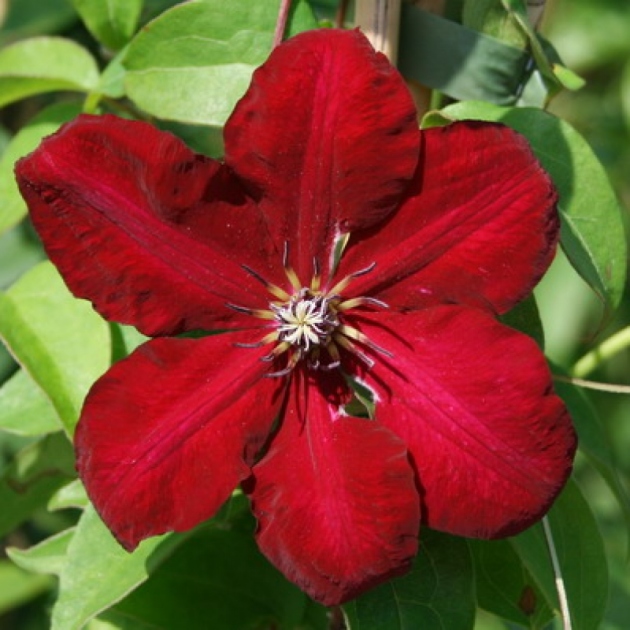
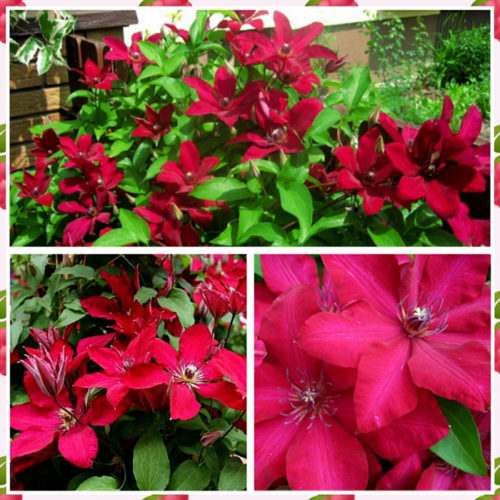
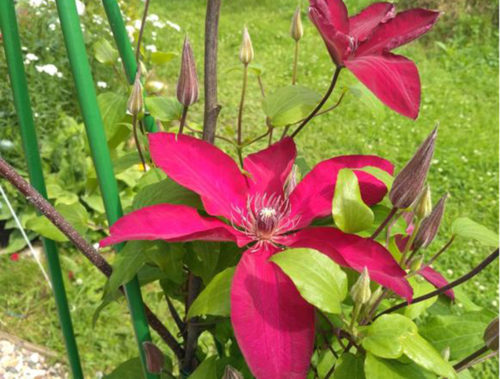
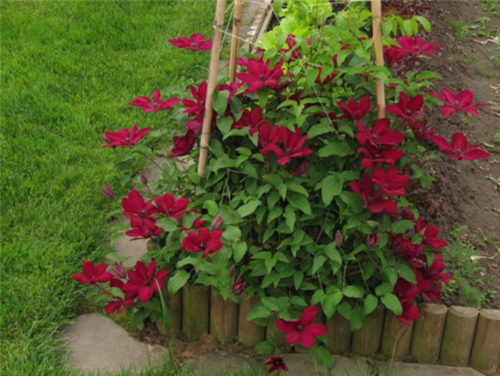
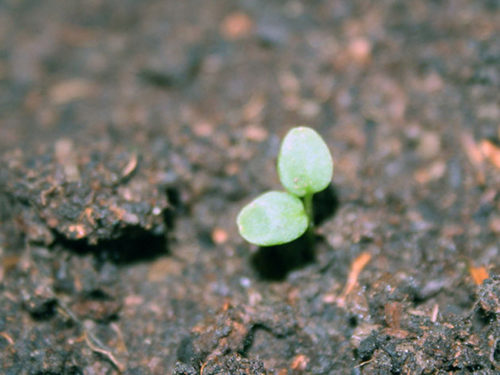

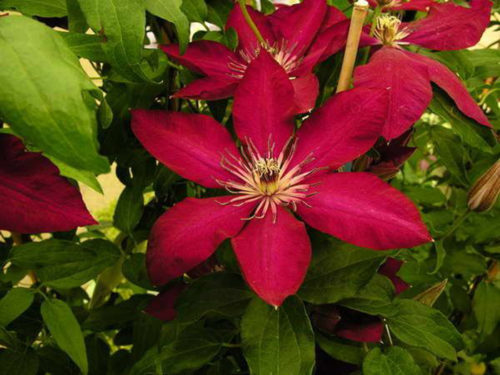

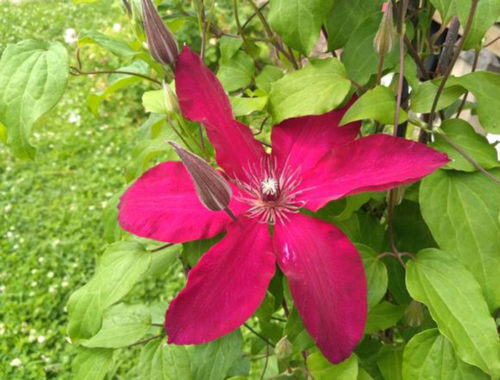
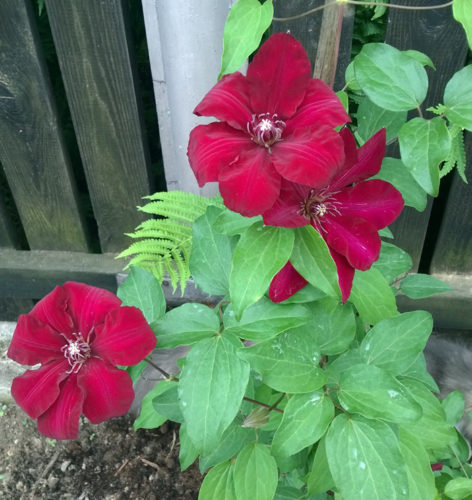
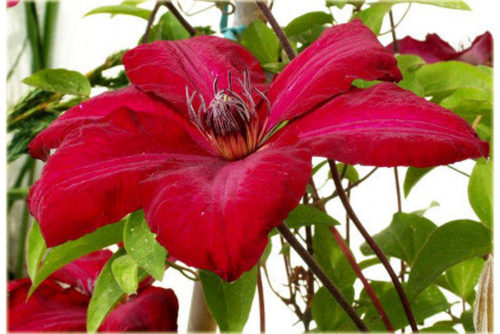
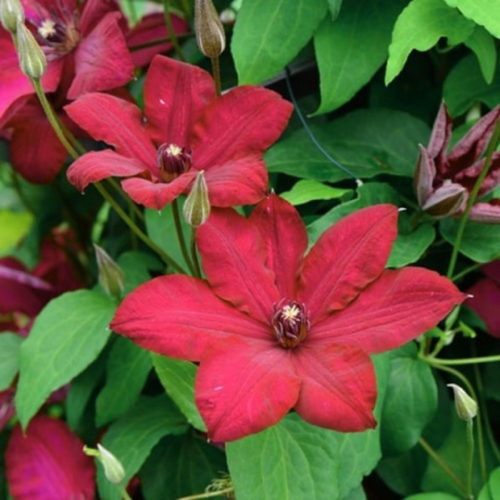
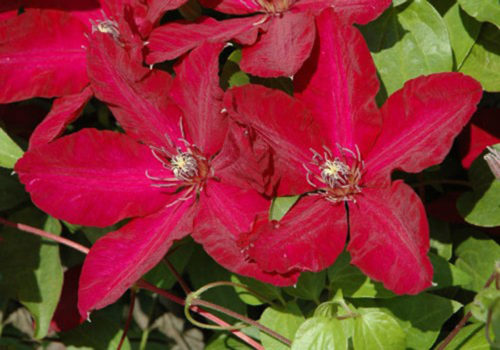












 Start a discussion ...
Start a discussion ...